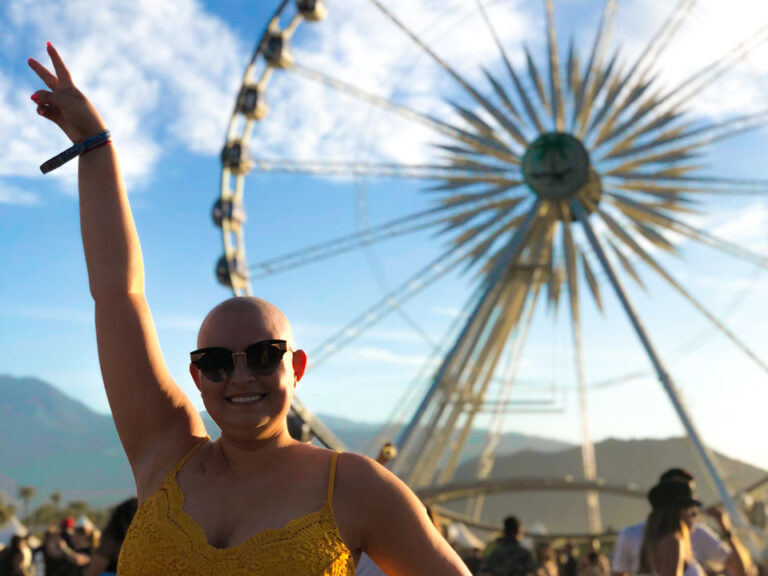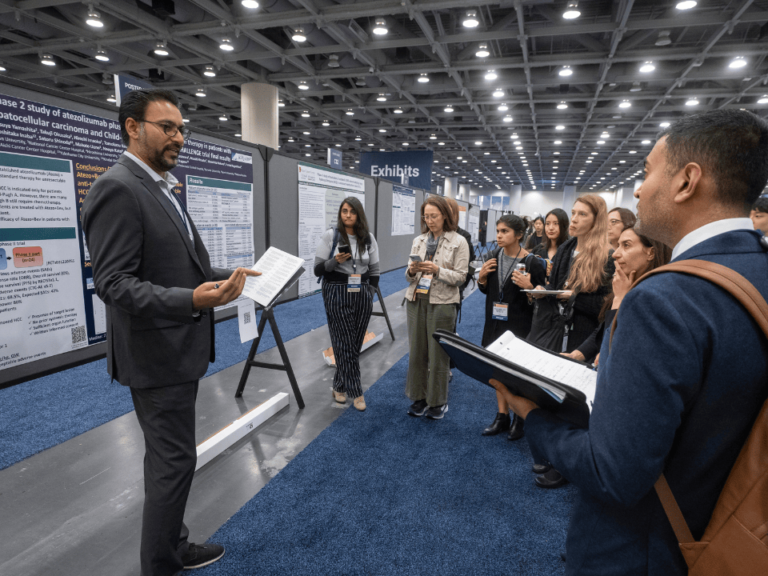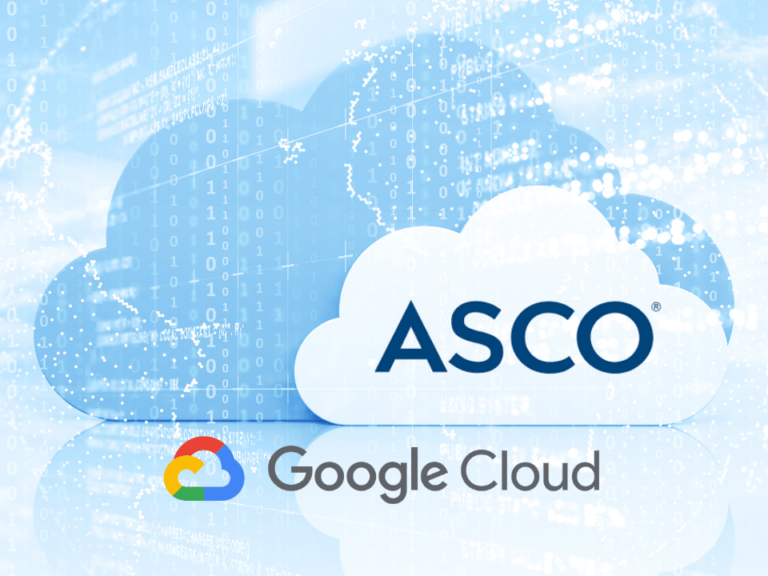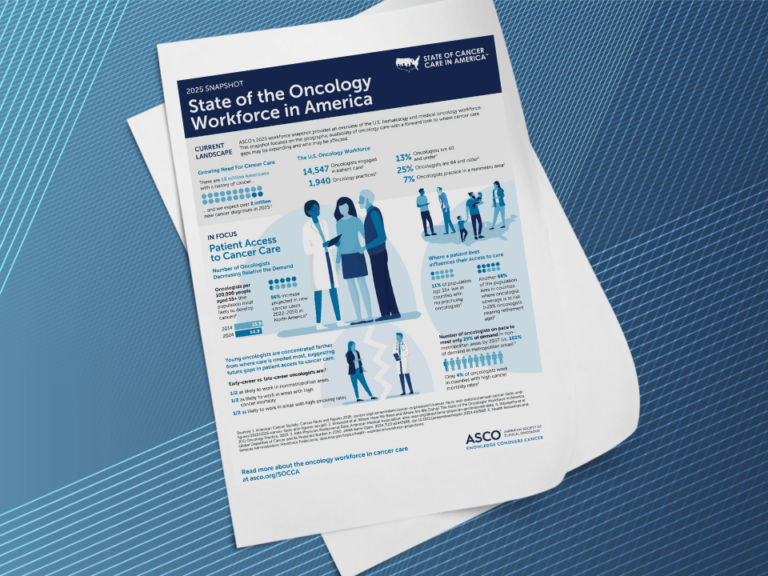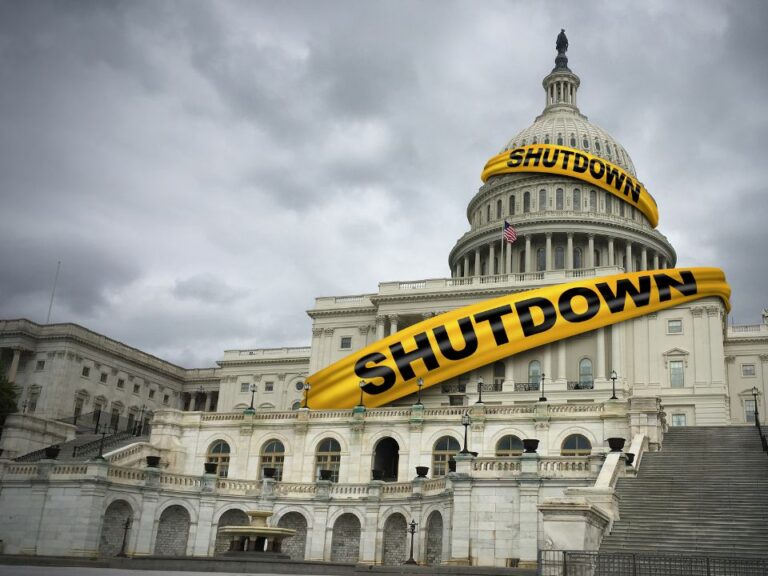Vice President Joe Biden challenged individual organizations and leading initiatives in oncology bioinformatics to interoperate and share data.
Speaking at the annual meeting of the American Society of Clinical Oncology in Chicago, Biden announced the NCI’s Genomic Data Commons as part of the National Cancer Moonshot Initiative, and urged others to collaborate with NCI.
“There are a number of you working to aggregate that data: [M2Gen’s] ORIEN, [American Association for Cancer Research’s] Project GENIE, QUILT Coalition, including [ASCO’s] CancerLinQ,” Biden said June 6, addressing about 6,000 ASCO attendees. “You’re not going to like this, but imagine if you all worked together.
“I’m not joking! Imagine if you all worked together. I’ve had a chance to speak with the head of each one of these organizations—they’re spending hundreds of millions of dollars. Imagine! Imagine, if it was coordinated.
“I’d like to issue a challenge to you. First, expand CancerLinQ so that it can meaningfully and seamlessly connect with other project networks like Project GENIE and ORIEN and QUILT and the GDC in pursuit of a national and international flow of patient data.”
An excerpted text of Biden’s remarks follows:
It’s good to see you all here. I didn’t realize how many of you were here, it’s quite a gathering. I should say at the outset, you’re the folks who, many of you, are the ones who are interfacing every day with the family, with the patient trying to figure out how you can give hope without giving false hope, how you can bring help where it’s available, and wondering why we can’t move faster.
Every year, thousands of oncologists and millions of patients all over the world await the news coming from this meeting. New breakthroughs, new therapies, new promises of cure. Hope. Hope. I know of no coterie of people in the world more desperately in need of hope than over the 16 million people with cancer.
This year your theme is harnessing the collective wisdom of oncologists around the world to put patients at the center of research and care. That’s exactly what I’m trying to do in the cancer moonshot, and it matters. And I might note parenthetically, if I allegedly have any expertise in the area of foreign policy and constitutional law—and I want you to know what you already do know, but I see it every day—as I travel the world, and I’ve now traveled over 1,200,000 miles as vice president for the president.
I was recently in the Middle East, in Abu Dhabi and Jordan and Israel and other parts, talking about ISIS. But with every leader I met with, in every one of the countries, without exaggeration, the first thing they said to me: “Mr. President, before we begin, can I talk to you about your moonshot?” I’m not joking.
We recently had 50 world leaders, heads of state at the White House for the nuclear summit, and before the president began, with all the tables arrayed around the east room, he in front of the fireplace and me on the opposite side by the hallway you see where all the press conferences are held. He said, “I know a lot of you want to speak to Joe about cancer, but we can do that afterwards.”
There are five countries, from Asia to the Middle East to Europe, with whom we are now attempting to work out memorandum of understanding on how we can better coordinate. This is an issue that I came to quite accidentally. I’m pretty good at what I do, I think. There’s never been a major undertaking I’ve been assigned where I haven’t known at least as much or more than the people advising me, except here. That’s why I need you. I need you and your colleagues and that’s why I’ve been travelling the nation trying to learn as much as I can as quickly as possible.
The cancer medical community has a difficult, and from my perspective, unique role in medicine. More than any of the other specialties, oncologists have to explore the unknown with their patients. In a literal sense, explore the unknown, because you don’t know some of the answers that are being sought by your patients. There are more than 200 different types of cancer, there aren’t 200 different kinds of diabetes or heart disease, and the unknown is frightening. I know from experience like many of you do.
Like every family who faces cancer, my family and I did everything in our power to learn everything we could about the cancer my Beau, my son, was fighting. We relied on the best doctors in the world to explain the unknown to us, and they were the best doctors in the world. We saw how our doctors and every one of you are constantly learning from direct experience, what will work and what won’t work from day to day—all the hopes of not just treating cancer, but changing it. I saw that no single oncologist or cancer researcher can find the answers on his or her own. The good news is that today, oncologists and cancer researchers realize they can’t do it alone either.
We’ve reached an inflection point, in my view, in the fight against cancer, where you are combining diverse disciplines unlike you did even 10 years ago. Virology, immunology, proteomics, and genomics are all offering profound promise that wasn’t there, I would argue, even five years ago. What’s required today extends beyond any individual or any individual discipline, beyond medicine itself. We have to use every weapon at our disposal if we’re going to meet our goal to help patients even more than you’re already helping them today. And to be honest with you, it requires somewhat of a change in mindset. It requires a lot more openness. Open data, open collaboration, and above all, open minds. Few of the ideas you’re engaged and exploring today to improve cancer and the cancer enterprise are entirely new.
For example, it wasn’t too long ago that immunotherapy was somewhere out in the hinterlands. In the early 1900s, a bone surgeon in New York named [William] Coley, following pioneers like Koch and Pasteur and Von Behring, developed a theory that post-surgical infections helped patients recover better from cancer by provoking the immune system. He began by injecting streptococcus and then dead bacteria into patients. When he did, he argued they survived cancer longer. Coley’s toxins provided the foundation for what would become immunotherapy.
But for the longest time, with good reason, there was the trilogy: find the tumor, excise it, use as targeted radiation as you can and as toxic a chemotherapy as you can without damaging surrounding cells. But what’s new today is that you’re now using all of the tools at your disposal. Our technology and understanding today dwarfs what existed even a decade ago. New biological capabilities enable us to specifically stimulate a patient’s body to fight a particular type of cancer. Faster, cheaper, more accurate genomic sequences, enhanced imaging technology that allows a doctor to see the specific location and impact of a cancer without entering the operating room, data infrastructure networks capable of sharing privacy-protected clinical data in real time. Advanced computational capabilities, including super computers that can do a thousand billion calculations per second, that if we aggregate enough data we’ll be able to help us interpret data and find new patterns of treatment success.
In so many other areas, which takes me back to the theme of your conference, harnessing the collective wisdom of all the disciplines, to improve the lives of your patients. When I announced the decision not to seek the nomination for president, in the Rose Garden with the president, and I said—it was almost a lament, I had not planned my statement—I said, “If I could have done anything, I would have wanted to be the president that ended cancer as we know it, because I believe it is now possible.”
The cancer moonshot grew out of that statement, and in the State of the Union the president announced that I would lead the effort, giving me absolute authority over every government agency that engages in it—every cabinet agency that has any impact on the fight against cancer. Our effort is guided by a few key missions: realigning the incentives of the research system to promote breakthrough progress in preventing and treating cancer, creating a new paradigm of generating, sharing, integrating data into enhanced patient care, accelerating, bringing new strategies, diagnoses, therapies, to patients in communities across the world, and identifying any unnecessary regulatory barriers that exist at the federal level—and they exist and stand in the way of allowing you to improve cancer care.
Now with those missions in mind, I’ve travelled the country and the world touching many if not all of the major nerve centers in the fight against cancer. I met with coalitions of cancer organizations that are attempting to aggregate cancer tissue, genomics, patient medical records, family histories and lifestyles. All in order to use supercomputing power we have today to find answers that we don’t have right now that would take the human eye a long time to find a pattern.
Last month, I spoke to the American Association of Cancer Research, and there appeared to be a consensus. There were, I think, 6,000, I’m not sure, it was a large number, a consensus relative to the need to first realign incentives to reward team science, by bringing together the expertise needed to answer big questions without being limited by jealousies between disciplines, laboratories and institutions to promote research that delivers results for patients. Help our researchers spend more productive time in the lab, and less time writing grant proposals. Share the data behind breakthroughs so that the field as a whole can move forward faster and avoid unnecessary redundancy. Measure progress in patient outcomes, not just the number of publications.
I spoke at a conference in April in the Vatican with Pope Francis, and laid out guideposts for international commitment and progress to meet the goals of the cancer moonshot, stating we should focus on prevention, access, and affordability around the world. And international response to cancer should reflect the same urgency we bring to infectious disease threats with the associated resources and international cooperation.
When we were worried about Ebola, we were able to aggregate tens of billions of dollars and the entire United States military. Because the World Health Organization couldn’t handle it, we did. That’s the kind of urgency we need with regard to cancer. Increased research and patient data sharing among researchers, institutions, foundations, and nations to at least support standardization of data and bio-repositories. We have to increase global government investment in cancer research to capitalize on this moment.
As I said, not only is there international consensus, but this is the only bipartisan thing left in America right now. You all think I’m kidding. When the president announced me to run this moonshot, immediately, half-a-dozen of the leading Republicans in the House and Senate, all good people working on this, called and said, “What do we need?” If I’d announced I was going to provide for peace in our time I wouldn’t have gotten a single call. But all kidding aside, this is a moment we’ve got to seize.
At the administration’s seventh Health Datapalooza last month, I challenged some of the best minds in technology, computer science, medicine, public health, and engineering, just as I’m asking you today, to develop new ways to assess the quality of medical data, to make it easier to share research in medical data, to find new ways to share the lessons that data can yield. Later this month I’ll be hosting the first cancer moonshot summit.
This will not only be held in Washington, but simultaneously in over 75 locations currently committed around the country, with more signing up every day, simultaneously. I’d urge you, go register to host your own. Join us in that moonshot. We need you. It’s your opportunity to get involved, to have the conversation be what you want it to be, to provide feedback and your ideas to the moonshot. The purpose is to bring together individuals, foundations, philanthropists, companies, institutions, under the national charge of doubling the rate of progress to ending cancer as we know it. And for everyone, from oncologists to patients to engaged citizens to commit to playing a part. Join us. Go to www.whitehouse.gov/cancermoonshot, because I’m committed to bringing together all the human, financial, and knowledge resources we have in the world to try to seize this moment. Everywhere I go, we talk about what is possible.
There’s an emerging consensus, first, is that immunotherapy is poised to effect more patients, more cancers, and become an increasingly critical part of the anti-cancer strategy, but the question is, “What’s next?”
Secondly, there are many variables that go into what triggers a cancer. Finding them all and identifying how to counter them with different therapies is only possible by examining large datasets for similarities in a large number of patients with the computing power we now possess, which as I said, is a thousand billion computations per second.
The first person to come to me, when the president announced that I would head this up, was the head of the Department of Energy, Ernie Moniz, a brilliant MIT scientist, laying out what the national labs had, the capabilities they had, and how they were prepared to bring it all to bear in this fight. There are a number of you working to aggregate that data: ORIEN, Project GENIE, QUILT Coalition, including CancerLinQ. You’re not going to like this, but imagine if you all worked together. I’m not joking! Imagine if you all worked together. I’ve had a chance to speak with the head of each one of these organizations—they’re spending hundreds of millions of dollars. Imagine! Imagine if it was coordinated.
Third, there’s a growing recognition, and all of you know this, of the need for more team science. Oncologists working with virologists, immunologists, chemical engineers, data science, technicians, surgeons, imaging and radiology specialists, and most importantly patients. The question for you is how to break down the barriers that hinder collaboration. You don’t intend to not collaborate. You don’t intend to put up barriers. But there are institutional barriers. We need teams of scientists, but also teams of organizations. I urge you to keep working closely with other organizations and the leading patient foundations to translate scientific discovery into meaningful treatments for your patients.
And fourthly, as personalized medicine and combination therapies become the norm for cancer treatment, and you know they’re relatively new, we need approaches, new approaches, to clinical trials. That was one of the epiphanies when I had when I started out around the field. I’ve spoken now to over 300 oncologists personally, five Nobel laureates. I’ve met with almost every major cancer institution in the country for three- and four-hour round tables with their leadership.
The one thing that was completely new to me was how damn difficult it was to get into a trial, or find out where one was being conducted. Or if you’re conducting one, find patients who can in fact qualify. I didn’t have that problem. I had a son at a great cancer hospital that was in pretty tough shape and at the end of the day became a clinical trial of one. What about the 96 percent of the people out there with cancer who would benefit? There’s got to be a better way. The answer has got to come from you guys. I can’t legislate it for you, but you know it’s true. I need your help. We can do much better than we’re doing. We need to share not only clinical data, but all of the data that will drive progress in the fight against cancer.
Before I came here today, I spent a couple hours over at the University of Chicago, for the public launch of the National Cancer Institute’s Genomic Data Commons. A platform built by the University of Chicago, paid for by the NCI, at the NCI’s request. [NCI] Acting Director Doug Lowy said it best, when he said, “What I see as transformative is, this is where the world is going, and the Genomic Data Commons is just a part of it.” He went on to say, “One of the initial goals is to bring all of the data into one place, analyze it and display it in a uniform way.”
This is a significant step forward, because of new DNA sequencing technology, we would be able to rapidly generate vast troves of cancer data and genomic data. But the information is scattered among different government and academic repositories. Most of it is out of the reach of scientists. We’re bringing it into one place. Your enterprise is much larger, it’s 400,000, or it should be 40,000. Initially, the Genomic Data Commons will have two petabytes of data. That’s two million gigabytes. From NCI-supported research, clinical trials, and the cancer genome analysts, to TARGET, which is the pediatric database, the largest amount of raw cancer genomic data ever stored in one location, public access.
It’s our hope that Genomic Data Commons will prove pivotal in advancing precision medicine where physicians attempt to tailor therapies to specific characteristics of a particular patient’s cancer. Our aim, the aim of Genomic Data Commons, is for researchers to have information at their fingertips about the relationship between abnormalities and mutations of genes and clinical outcomes. This database will be accessible through an NCI portal, it’ll be interactive and searchable and available to everyone. Scientists will be able to reanalyze the raw data according to their interests, what they are looking for.
Those most likely to use the Genomic Data commons are researchers, I acknowledge that, research clinicians. But that’s only at the beginning, one important point I want to emphasize is that all clinical trials funded by the NCI from this point on will have to be submitted to the database. The leaders of our nation’s major cancer centers are, as I speak, working on the model consent form that will enable them to supplement this data in huge quantities. Each year, the Genomic Data Commons will add another petabyte or more to storage to accommodate new data including soon-to-come genomic databases from NCI-sponsored clinical trials. Researchers will be able to go to one place and look at the raw genomic sequencing that has already been done for more than 20 different cancers and associated clinical data, diagnosis, treatment history, survival data, and other information.
But this is only the beginning because more raw genomic sequencing of different cancers is underway and will be included. And after that data is aggregated and analyzed, we’ll be able to share the lessons of data yield to others so others can build on the work that comes out of this Genomic Data Commons. This is good news for the fight against cancer. The launch of this new national resource: anyone can freely access raw genomic and clinical data at the outset for 12,000 patients, with more records to follow. Hastening the pool of research, and researchers, who can access data and decreasing the time it takes for them to view and find new patterns in that data is critical to speeding up the development of lifesaving treatments for patients.
I know there’s concern about data security and authorized access but I want to assure you, Genomic Data Commons has built important safeguards to protect patient privacy, enable and secure data downloading, and provide for no liability. We’re making this enormous database available and we expect that people will benefit from it to share back. We need oncologists and researchers around the world to upload your raw genomic data. It will not only drive research progress faster, but it will eventually help individual doctors determine the most effective drug or course of treatment for the particular patients, particularly those not associated with the large research universities. And all of you know it’s the right thing to do. It’s the quickest way for us to move forward and it’s not technically hard to do it.
Let me give you an example. Here in Chicago in 1960, at the University of Chicago, the Center for Research in Security Prices, that’s a stock exchange, created a database of every stock and bond transaction going back to 1926. That database has been used by countless thousands of researchers and professionals to develop and test their theories on how the market works. We can easily do the same thing for medicine. As one top cancer researcher told me, “We have to allow the data to actually yield the answers by being willing to see the whole picture, not just what we expect to see.” That can be fully within our power. To succeed with the moonshot, I desperately need your help.
I’d like to issue a challenge to you. First, expand CancerLinQ so that it can meaningfully and seamlessly connect with other project networks like Project GENIE and ORIEN and QUILT and the GDC in pursuit of a national and international flow of patient data. Second, help us create a system that awards team science and makes it the norm, not the exception, that promotes greater sharing of data and that shares resources and disseminates breakthroughs more rapidly. As all of you know, the current system is still based on the cult of the individual and it fails to reward teamwork adequately, The way in which we award publication credit, tenure credit, patient ownership, that can all be improved to support team approaches. But you have to come up with it.
Thirdly, help us create a new system that adequately supports every patient who qualifies for and wants to get into a clinical trial, to be able to do just that. No one should have to forego a critical clinical trial because they can’t afford the gas to get there or a babysitter at home. Over the years there’s been a movement away from government-sponsored trials to industry-sponsored trials. Industry-sponsored trials are very important, they’re vital, but they do not answer all of the essential questions, like comparing drugs from different companies, focusing on bringing improved treatments for rare diseases, or testing the efficacy of approaches that do not have a commercial value. We need to maintain a broad spectrum of trials that answer essential questions, not all of which will have immediate commercial value. And we need you to help us get there.
Our ability to penetrate the mysteries of cancer depends on our willingness, and especially your willingness to see beyond the usual and the expected. The annals of ASCO are filled with revelations that surprise and upended the expectation, the expected course of treating cancer, and collectively you have saved countless lives. As the great leader Benjamin Disraeli once said, “Diligence is the mother of good fortune,” I commend your diligence and urge you in your endeavors so that new revelations continue to emerge. “The good fortune of America is closely tied to the good fortune of all humanity,” Marquis de Lafayette said at the time of the revolution. That’s true today.
The whole world is looking to you. Your success can literally change the world. We need you now more than we ever have. The expectation is, if there’s no real change in the next six years, there will be 25 million cancers. You’re the most dedicated, decent, hard-working people, and the greatest minds we have in this country. My plea to you is, help us help you figure out in addition to trying to get billions more dollars committed to this fight for the federal government which I think we can do. Help us help you how to aggregate more information available immediately.
Do you realize if you got an advance grant from DARPA to work on a space program, that even if it had potential military application your research is immediately instantaneously made available to the whole world.
How can that be? And that not be the case in a scourge facing humanity. They’re not easy answers. But no one knows the problem or the potential solutions better than all of you assembled here today. We not only need your continued scholarship and your incredible capacity, we need some ideas to speed this process.
May God bless you all and may God protect our troops. Thank you very much.
Katie McKinney contributed to this story.


